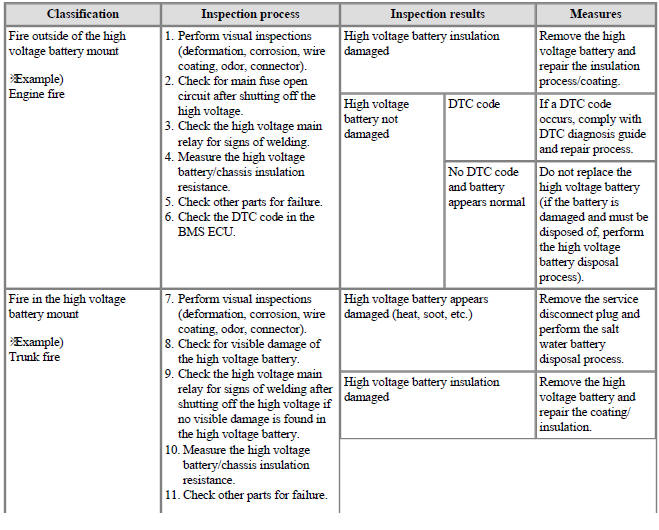KIA Niro: High voltage battery system inspection guide
Kia Niro - First generation - (DE) (2017-2022) - Service and Repair Manual / Service Highlight / High voltage battery system inspection guide
Warning
- Be sure to read and follow the "General Safety Information and Caution" before doing any work related with the high voltage system. Failure to follow the safety instructions may result in serious electrical injuries.
- Be sure to read and follow the "High Voltage Shut-off Procedures" before doing any work related with the high voltage system. Failure to follow the safety instructions may result in serious electrical injuries.
- Carry out a visual inspection to determine whether the vehicle requires general repair or accident repair.
- For the general repair, perform the repair based on the repair process for that DTC code.
- For the car accident repair, determine the accident type before repair.
1) Electrical Accidents
- Over-charge/discharge: Displays a battery over voltage (P1B71) code /low voltage (P1B70) code (Refer to the DTC diagnosis guide).
- Short: Displays a high voltage short (P1B77, P1B25) codes (Refer to the DTC diagnosis guide).
2) Fire


3) Collision

4) Submersion


- Main Fuse Inspection | Checking for Welding in the High Voltage Main Relay
- Measuring insulation resistance using an insulation tester
- Voltage Check
- Service Highlight / Inspection Mode Procedures
READ NEXT:
 Main Fuse Inspection | Checking for Welding in the High Voltage Main Relay
Main Fuse Inspection | Checking for Welding in the High Voltage Main Relay
Turn the ignition switch OFF and disconnect the auxiliary 12V battery negative (-) terminal.
Shut off the high voltage.
(Refer to Hybrid Control System - "High voltage Shut-off Procedures")
Remove the center tra
 Measuring insulation resistance using an insulation tester
Measuring insulation resistance using an insulation tester
Warning
Be sure to read and follow the "General Safety Information and
Caution" before doing any work related with the high
voltage system. Failure to follow the safety instructions may result in
serious electrical injuries.
Be sure to
SEE MORE:
 Coolant Repair procedures
Coolant Repair procedures
Refilling And Bleeding
Warning
Never remove the cap when the engine is hot. Serious scalding could
be caused by hot fluid under high pressure escaping
from the reservoir.
Warning
When pouring inverter coolant, be sure to shut the relay box lid
 Smart Cruise Control (SCC)
Smart Cruise Control (SCC)
Smart Cruise Control (SCC) switch
Front radar unit
Description
System Function
Forward Collision-avoidance Assist (FCA) : Detects the risk factors on
the road and warn the driver and activate the
emergency brake to prevent colli
Categories
- Home
- KIA Niro EV, Hybrid - Second generation - (SG2) (2021-2024) - Owner's manual
- Kia Niro - First generation - (DE) (2017-2022) - Service and Repair Manual
- Contact Us
